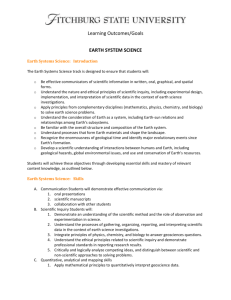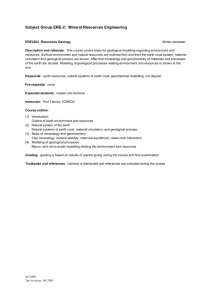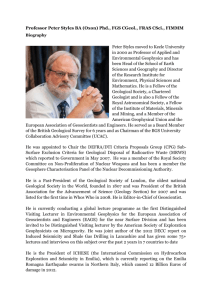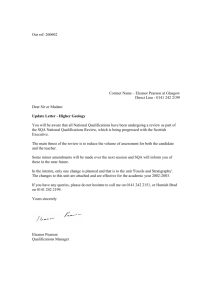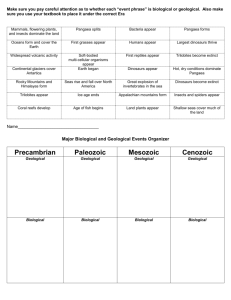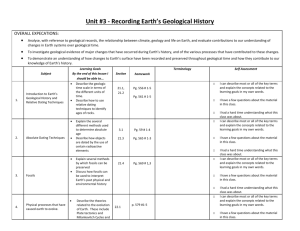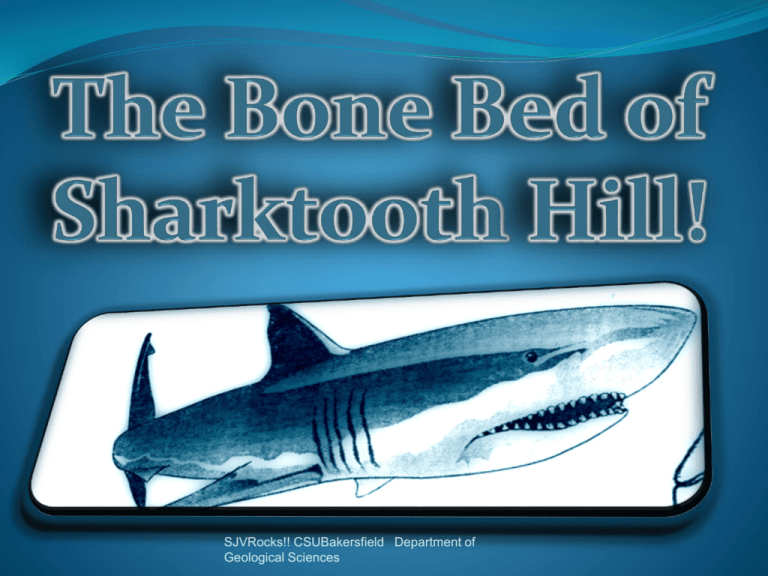
SJVRocks!! CSUBakersfield Department of
Geological Sciences
Why?
These two shark teeth
were found near Hart Park.
Why do you think there are
shark teeth buried in the
San Joaquin Valley?
SJVRocks!! CSUBakersfield Department of
Geological Sciences
Objective:
We will create a model that explains
the presence of marine fossils in the
San Joaquin Valley using the Plate
Tectonic Theory to help us
understand the change of geography
over time.
SJVRocks!! CSUBakersfield Department of
Geological Sciences
Vocabulary
Fault: a break along the crust of the
earth where one or both sides move
Illustrations by: U.S. Geological Survey (Lead Author);Michael Pidwirny (Topic Editor) "Fault". In: Encyclopedia of Earth.
Eds. Cutler J. Cleveland (Washington, D.C.: Environmental Information Coalition, National Council for Science and the
Environment). [First published in the
Encyclopedia
of Earth March
12, 2011; of
Last revised Date March 13, 2011;
SJVRocks!!
CSUBakersfield
Department
Retrieved June 14, 2011 <http://www.eoearth.org/article/Fault>
Geological Sciences
Vocabulary
Tectonic Plate:
Plate:
a large, hard slab
of solid rock.
Tectonics: comes from the
Greek root "to build."
Putting these two words together, we get the term plate
tectonics, which refers to how the Earth's surface is built
of plates.
Illustration by http://hamertech.wikispaces.com are licensed under a Creative
SJVRocks!! CSUBakersfield Department of
Commons Attribution Share-Alike 3.0 License.
Geological Sciences
Vocabulary
Subduction: the process of the oceanic plate
colliding with and moving under a continental
plate
Continental Crust
Illustrationby http://geology.com/nsta/
SJVRocks!! CSUBakersfield Department of
© 2005-2011 Geology.com. All Rights
Reserved
.
Geological
Sciences
Vocabulary
Fossil: form when animals or plants die in the
loose sediments (what we commonly call dirt)
and are covered by more layers of material
First and last photographs by Teri Madewell. Middle photograph by How Are
Fossils Formed? An E-Book About...Fossils, By:
Kamryn Herrington
& Bryn TownerDepartment
SJVRocks!!
CSUBakersfield
http://www.valdosta.edu/~klherrington/ebook.html
Geological Sciences
of
Vocabulary
Marine:
coming from
the ocean
Photograph by Brown University (2008, February 23). Resilience Science Is
Promising
Approach Toof
Marine Conservation. ScienceDaily. Retrieved June
SJVRocks!! CSUBakersfield
Department
14,
2011,
from
http://www.sciencedaily.com
Geological Sciences
/releases/2008/02/080217102153.htm
Bakersfield was once
under the Pacific Ocean!!
SJVRocks!! CSUBakersfield Department of
Geological Sciences
SJVRocks!! CSUBakersfield Department of
Geological Sciences
SJVRocks!! CSUBakersfield Department of
Geological Sciences
Fossilization of
shark teeth
SJVRocks!! CSUBakersfield Department of
Geological Sciences
Fossils of Marine Animals
If you look
really hard….
You can find
Shark Teeth….
SJVRocks!! CSUBakersfield Department of
Geological Sciences
In the hills
outside of
Bakersfield……
And
Other
Marine
Animal
Fossils….
Fossils of Marine Animals
Cow
shark
tooth
Basking
shark
tooth
SJVRocks!! CSUBakersfield Department of
Geological Sciences
Mako
shark
tooth
Ray
crushing
plate
SJVRocks!! CSUBakersfield Department of
Geological Sciences
Let’s travel back in time millions of years…
SJVRocks!! CSUBakersfield Department of
Geological Sciences
SJVRocks!! CSUBakersfield Department of
Geological Sciences
Late Paleocene 59 mya
Early Eocene 52 mya
SJVRocks!! CSUBakersfield Department of
Late Miocene 10 myaGeological Sciences
Pliocene 4 mya
Early Miocene 21 mya
Pleistocene 0.6 mya
Why is Bakersfield in a Valley and
no longer under the Pacific Ocean?
The subduction of the oceanic plate beneath the
North American Plate caused the uplift of the Sierra
Nevada Mountains. Erosion of sediment from the
Sierra Nevada filled in the San Joaquin Valley and
SJVRocks!! CSUBakersfield Department of
continues
to this day.
Geological
Sciences
Sea Level
.6
Million
Years
Ago
10
59
21
30
45
52
4 Million
MillionYears
YearsAgo
Ago
SJVRocks!! CSUBakersfield Department of
Geological Sciences



